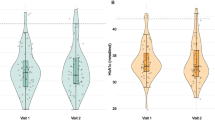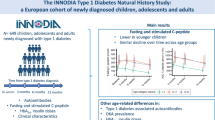Summary
Patients with type I (insulin-dependent) diabetes mellitus maintain B-cell function for a varying period of time after onset. This is commonly held to account for post-initial remission. To estimate residual B-cell function we measured plasma and 24-h urinary C-peptide in 68 type I diabetic patients (age range 4–35 years, within 10–180 days of the onset of symptoms, typed for HLA-A,-B,-C and DR loci. A positive correlation (r=0.26; p<0.05) was found between urinary C-peptide levels and the age of the patient. The analysis of variance of urinary C-peptide values on the basis of the presence or absence of DR3 and DR4 antigens revealed that the DR3-positive patients had reduced excretion (15.2±9.2 SD μg/24h) with respect to the others (22.7±15.5 SD μg/24h) (F=6.35; p<0.05). No interaction effect was found in DR3/4 positive patients. Hence, late onset patients appear to have higher residual C-peptide secretion. In the light of these findings, the assessment of B-cell function and genetic profile may be useful in predicting which patients are likely to have remission periods and identifying the metabolic consequences of even minimal endogenous insulin secretion.
Similar content being viewed by others
References
Aurbach-Klipper J., Sharph-Dor R., Heding L. G., Karp M., Laron Z.: Residual B cell function in diabetic children as determined by urinary C-peptide—Diabetologia24, 88–90, 1983.
Bottazzo G. F.: β-cell damage in diabetic insulitis: are we approaching a solution?—Diabetologia26, 241–249, 1984.
Buschard K., Madsbad S., Rygaard J.: Suppressor cell activity in patients with newly diagnosed insulin-dependent diabetes mellitus. A prospective study—J. clin. Lab. Immunol.8, 19–23, 1982.
Canivet B., Harter M., Viot G., Balarac N., Krebs B. P.: Residual beta-cell function in insulin-dependent diabetics: evaluation by circadian determination of C-peptide immunoreactivity—J. endocrinol. Invest.3, 107–111, 1980.
Eisenbarth G. S.: Type I diabetes mellitus. A chronic autoimmune disease—New Engl. J. Med.314, 1360–1368, 1986.
Faber O. K., Binder C.: B-cell function and blood glucose control in insulin-dependent diabetics within the first month of insulin treatment—Diabetologia13, 263–268, 1977.
Gepts W., LeCompte P. M.: The pancreatic islets in diabetes—Amer. J. Med.70, 105–115, 1981.
Heding L. G.: Radioimmunological determination of human C-peptide in serum—Diabetologia11, 541–548, 1975.
Hoogwerf B. J., Rich S. S., Barbosa J. J.: Meal stimulated C-peptide and insulin antibodies in type I diabetic subjects and their non-diabetic siblings characterized by HLA-DR antigens— Diabetes34, 440–445, 1985.
Logothetopoulos J., Valiquette N., Madura E., Cvet D.: The onset and progression of pancreatic insulitis in the overt, spontaneously diabetic, young adult BB rat studied by pancreatic biopsy—Diabetes33, 33–36, 1984.
Ludvigsson J.: Insulin antibodies in diabetic children treated with monocomponent porcine insulin from the onset: relationships to B-cell function and partial remission—Diabetologia26, 138–141, 1984.
Ludvigsson J., Heding L. G.: Beta-cell function in children with diabetes. In:Binder C., Rubenstein A. H. (Eds): Proceedings of an International C-peptide Research Symposium— Diabetes27 (Suppl. 1), 230–234, 1978.
Ludvigsson J., Säfwenberg J., Heding L. G.: HLA-types, C-peptide and insulin antibodies in juvenile diabetes—Diabetologia13, 13–17, 1977.
Ludvigsson J., Samuelsson U., Beauforts C., Deschamps I., Drash A., Francois R., Herz G., New M., Schober E.: HLA-DR3 is associated with a more slowly progressive form of type I (insulin-dependent) diabetes—Diabetologia29, 207–210, 1986.
Madsbad S.: Prevalence of residual B-cell function and its metabolic consequences in Type I (insulin-dependent) diabetes—Diabetologia24, 141–147, 1983.
Madsbad S., Faber O. K., Binder C., McNair P., Christiansen C., Transbøl I.: Prevalence of residual beta-cell function in insulin-dependent diabetics in relation to age at onset and duration of diabetes. In:Binder C., Rubenstein A. H. (Eds): Proceedings of an International C-peptide Research Symposium—Diabetes27 (Suppl. 1), 262–264, 1978.
Madsbad S., Krarup T., Regeur L., Faber O. K., Binder C.: Insulin secretory reserve in insulin-dependent patients at time of diagnosis at the first 180 days of insulin treatment— Acta endocrinol. (Kbh.)95, 359–363, 1980.
Mirouze J., Selam J. L., Pham T. C., Mendoza E., Orsetti A.: Sustained insulin-induced remission of juvenile diabetes by means of an external artificial pancreas—Diabetologia14, 223, 1978.
National Diabetes Data Group: Classification and diagnosis of diabetes mellitus and other categories of glucose intolerance—Diabetes28, 1039–1057, 1979.
Rabinowe S. L., Eisenbarth G. S.: Immunotherapy of Type I (insulin-dependent) diabetes mellitus. In:Andreani D., Di Mario U., Federlin K. F., Heding L. G. (Eds): Immunology in Diabetes. Kimpton Medical Publications, London-Edinburgh, 1984; pp 171–175.
Rappaport E. B., Ulstrom R. A., Etzwiler D. D., Fife D., Hedlung B. E., Steffes M. W.: Urine C-peptide, beta-cell function and insulin requirement—Amer. J. Dis. Child.134, 1129–1133, 1980.
Srikanta S., Ganda O. P., Eisenbarth G. S., Soeldner J. S.: Islet cells antibodies and beta cell function in monozygotic triplets and twins initially discordant for type I diabetes mellitus—New Engl. J. Med.308, 322–325, 1983.
Van Leeuwen A., Van Rood J. J.: Description of B cell methods. In:Terasaki P. I. (Ed.): Histocompatibility testing. UCLA, Los Angeles, 1980; pp 278–279.
Werther G. A., Turner R. C., Jenkins P. A., Baum J. D.: Twenty-four hour profiles of plasma C-peptide in Type I (Insulin-dependent) diabetic children—Diabetologia22, 245–249, 1982.
Author information
Authors and Affiliations
Rights and permissions
About this article
Cite this article
Giordano, C., Galluzzo, A., Pantò, F. et al. Prevalence of residual B-cell function related to age at onset and genetic profile in newly diagnosed type I diabetics. Acta diabet. lat 24, 317–323 (1987). https://doi.org/10.1007/BF02742964
Received:
Issue Date:
DOI: https://doi.org/10.1007/BF02742964




